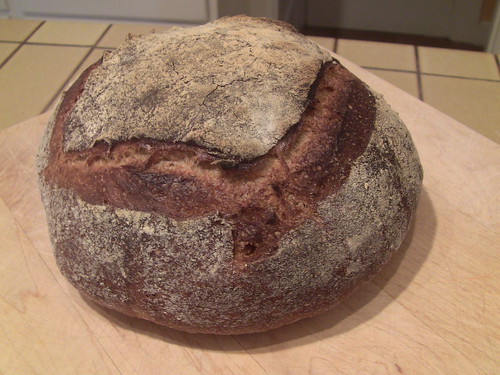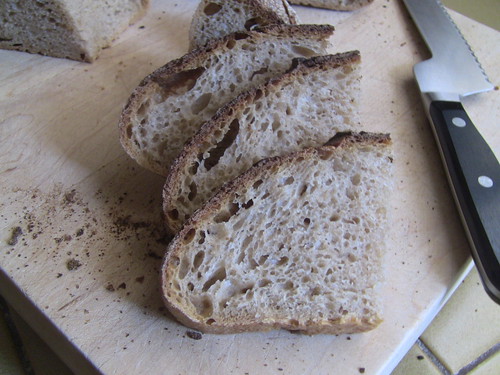One of the first tips in on which my brother David clued me when I started baking bread was to keep a store of sourdough starter food on hand. He recommended a blend of 70% AP flour, 20% whole wheat flour and 10% whole rye flour. I adopted that blend and that’s what my starter has thrived on for these 18 months. I also like the convenience of mixing up 300 or 400 grams of the blend at a time and keeping it in a jar, so starter feeding takes just a couple minutes.
As I’ve been playing with flour combinations for my pain de campagne, I’ve come to enjoy the flavor of blends with about 70% to 80% white flour and the rest a combination of rye and whole wheat. This week, it struck me that I’d never made a bread with the same blend as I use for starter food. So I made a batch of 70/20/10 sourdough pain de campagne.
I basically used the same technique as for my “San Francisco Country Sourdough”, except, seeking sourness, I used a higher percentage of pre-fermented flour and a longer fermentation for the levain. This formula uses a two-stage levain build, with the second stage levain retarded in the fridge, and has 40% pre-fermented flour.
So here’s how I figgered it:
Formula (in grams) Yields approximately 1600 grams of dough
Ingredient | 1st Levain Build | 2nd Levain Build | Final Dough | Total | Bakers % |
Culture/Levain | 40 (50% hydr) | 330 | 764 |
|
|
Water | 145 | 217 | 278 | 640 | 70% |
AP Flour | 100 | 150 | 380 | 630 | 69.5% |
WW Flour | 30 | 45 | 109 | 184 | 20.3% |
Rye Flour | 15 | 22 | 55 | 92 | 10.2% |
Sea Salt |
|
| 17 | 17 | 1.8% |
Step 1: Mix up 1000 grams of flour blend: 700 grams of AP, 200 grams of whole wheat and 100 grams of whole rye.
Step 2: One evening (two days before baking, so this should be a Thursday or Friday evening if you need a weekend day for the main labor), take 40 grams of your seed starter and dissolve it in 145 grams of cold water (mine was 44 F). Then mix in 145 grams of the flour blend. (My seed starter is at 50% hydration, but if yours is different, you can adjust the water to approximate the same hydration in the first build). Cover and leave at room temperature over night.
Step 3: Next morning (12 hours for me), dissolve the nice bubbly levain in 217 grams of cool water (mine was 74 F). Then mix in 217 grams of the flour blend. Cover and leave at room temperature for 8 to 10 hours until nice and bubbly. Refrigerate the levain over night.
Step 4: Next morning, pull the levain out of the fridge and let it warm up for 30 to 60 minutes. Dissolve the levain in 278 grams of warm water (mine was 85 F) . Then mix in 544 grams of the flour blend to a shaggy mass. Let it autolyse for 45 to 60 minutes. Mix in 17 grams of sea salt. I massaged the salt in by hand for about 3 or 4 minutes. I’d call it moderately short of moderate development.
Step 5: Primary ferment for 4 or so hours. Stretch and fold the dough, just 4 or 5 turns each time, at approximately one hour intervals. I did the first two S&Fs in the bowl and the third on a lightly floured board. After 4 hours, my dough had increased in size maybe 30 % or so and seemed pretty airy. In retrospect, it could have gone another hour.
Step 6: Divide the dough into two and pre-shape as boules. Let the dough balls rest 30 to 45 minutes.
Step 7: Shape the loaves as boules or batards and place in floured bannetons. Cover the bannetons with a damp towel or place them in sealed plastic bags. Proof at room temperature for 1 ½ to 2 ½ hours. [ALTERNATIVE: After proofing, place covered bannetons in fridge over night.] I baked one without overnight retardation and one with. The “same-day” loaf proofed for just under 2 hours. It passed the poke test, but another 30 minutes would have improved the openness of the crumb. The second (retarded) loaf warmed at room temperature for about 2 1/2 hours before going in the oven.
Step 7 ½: Preheat oven with baking stone and steaming apparatus to 500 F enough in advance so your stone is very well heated. I use a combination of a 10 inch cast iron pan with lava rocks and Sylvia’s magic steam towels.
Step 8: When loaves are fully proofed, slash and put in oven. As soon as the oven returns to 500 F, turn it down to 450 F. Bake 15 minutes with steam, then an additional 20-25 minutes without steam. Rotate the loaves if necessary for even browning. For the retarded loaf, I also sprayed the oven walls with water after about 8 minutes. I baked the retarded loaf a little hotter, leaving the oven at 500 for about 8 minutes.
Step 9: When the loaves are fully baked (205+ F internal temperature and dark crust), turn off the oven and leave the loaves on the stone with the oven door ajar for 10 minutes.
Step 10: Cool the loaves on a rack for at least an hour.
Both of the loaves have a very crispy dark crust and a moist, medium-chewy crumb. Neither loaf got great oven spring, but the crumb was airy, if not real open with big irregular holes. The retarded loaf has a more open crumb and a darker crust. Both have a nice sour tang. The retarded loaf is distinctly sourer, very much what I was going for.
One of you baking chemists could probably tell me what the heck I did right.
I think one of the next experiments will be to put more (or all) of the rye flour in the levain, per David’s suggestion.
This was a successful experiment and will lead to further refinements. It could be favorite if it didn’t involve a four-day process.
Submitted to YeastSpotting
Glenn
- GSnyde's Blog
- Log in or register to post comments





Nice bake Glenn.
So do you think the 2 part levain build added another dimension to the end result?
Yes. I defer to the expert baking chemists to tell me whether it was an acetic acid flashback or lactic acid reflux or what. But I think using more pre-fermented flour, some of which had fermented over two to three days, added to the sour character.
Glenn
I'm no chemist either, but I tend to lean towards using a high percentage of preferment in my doughs which I learned from Peter Reinhart ABED. I usually have around 75% starter in my doughs and have found it works excellent. I do want to try your method for the 2 phase build and experience this for myself.
Thanks for replying.
Ian
Glenn. Like your experiment for sour too. Looks like you got some decent spring with the way the slashes opened up. Love the dark crust. 'Brown food tastes good' is what Anne Burrell says.
Appreciate the comment.
Glenn
Looks good Glenn.!
I imagine those were very tasty loaves.
You've given me 3 or 4 new ideas for variations I'd like to try.
David
Thanks, David.
If I'm giving you ideas, I must no longer be a half-baked baker.
You would like this bread. It's got that SF Sourdough flavor of carbon and sour. It'd be great under Dungeness Crab.
Glenn
Beautiful looking bread Glenn. I love that dark caramelisation and cracking of the crust. There is so much flavour there. It looks like just the kind of bread I like to eat. This is also the kind of loaf that is going to improve in flavour over time. Nice baking.
Syd
Thanks, Syd. Yes, this bake is very flavourful (note: I'm bilingual). We'll see if it's improved today.
Glenn
Ha! Ha! Well, why anybody would want to take the 'u' out of flavour beats me. Unless of course you wanted to put it back in the front, as in 'uflavor' for the name of a new fangled range of spices that you could use in conjunction with some iPad recipe app.
Best,
Syd
Beautiful crumb and crust, Glenn!
Happy Easter,
Sylvia
I was thinking yesterday how great this bread would be baked in a WFO. It could use a little smoky flavor.
Glenn
all ash and coals would be swept out for baking most breads...focaccia and pizza are among my favorite baked with fire and smoke.
Sylvia
Yes, I don't know enough about the chemistry (I've barely mastered baker's math). But I know that more whole grain in the levain will increase flavor. Thanks for the nice comments.
Glenn
Great Results, Glenn!
4 Days! Unfortunately, I'am not that patient, never will be.
Nice work! both boules look great, and i know they taste great too. I prefer the crumb on the second one with the crust of the first :)
Those multi-build loaves should have a excellent shelf life.
If doctors can do face transplants, maybe I can graft one crust onto another loaf. Thanks, Khalid.
Glenn
very nice looking loaves - thanks for posting, it looks well worth trying!
If you do try it, let us know how it goes.
Glenn
This looks and sounds like my kind of loaf, Glenn. I love tangy sourness, deep color and hole-y crumb. This one has it all! I'm going to have to put this on my list. :)
Janie
Janie--
My formula of last week is being tweaked this week, and for the better, I think. Like brother David, I am an inveterate serial experimenter (I'd say "tweaker" except that has other connotations). Except David's experiments are more methodical (and reliable) and mine are, more or less, instinct-driven.
I will blog on this later, but for now I'll just say that--seeking sourness--I put a larger proportion of the whole grains, and less AP flour, in the levain builds, and more AP flour in the final dough. Same 70-20-10 proportions when all added up in the total dough formula, but not 70-20-10 at each step. I've only just had a first taste, but I think the result is sourer. The other tweak was shorter fermentation and proofing times.
I'll report in more detail after the real test--cracked crab and sourdough!
Thanks for the comment. I hope you like whichever formula you try.
Glenn
Did you take any pictures?
Glenn